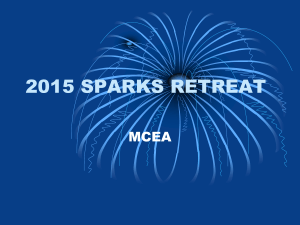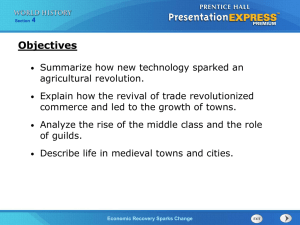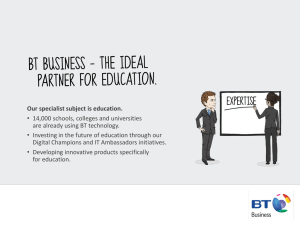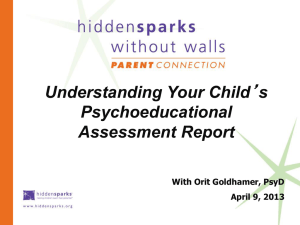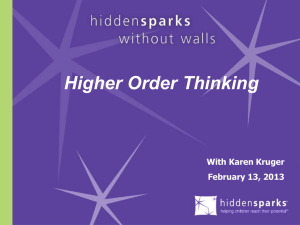Welcome to Hidden Sparks Without Walls. We will be starting shortly*
advertisement
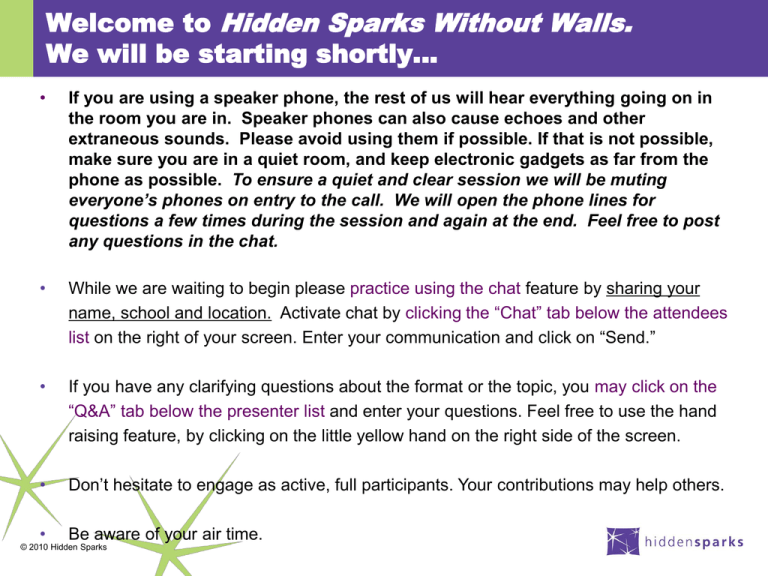
Welcome to Hidden Sparks Without Walls. We will be starting shortly… • If you are using a speaker phone, the rest of us will hear everything going on in the room you are in. Speaker phones can also cause echoes and other extraneous sounds. Please avoid using them if possible. If that is not possible, make sure you are in a quiet room, and keep electronic gadgets as far from the phone as possible. To ensure a quiet and clear session we will be muting everyone’s phones on entry to the call. We will open the phone lines for questions a few times during the session and again at the end. Feel free to post any questions in the chat. • While we are waiting to begin please practice using the chat feature by sharing your name, school and location. Activate chat by clicking the “Chat” tab below the attendees list on the right of your screen. Enter your communication and click on “Send.” • If you have any clarifying questions about the format or the topic, you may click on the “Q&A” tab below the presenter list and enter your questions. Feel free to use the hand raising feature, by clicking on the little yellow hand on the right side of the screen. • Don’t hesitate to engage as active, full participants. Your contributions may help others. • Be aware of your air time. © 2010 Hidden Sparks Mid-Year Modifications to Your Classroom to Enhance Student Success With Karen Kruger December 15, 2010 Welcome & Conference Etiquette • Below are some tips that will help make this conference call successful. • PLEASE NOTE: We will be muting phones automatically, but when we open the lines for questions we will want to ensure that those questions can be heard and answered without undue background noise. • Use the right phone. - Cell phones can be included in conference calls, but some can also cause static on the lines. Try to use a landline phone if possible. Speakerphones pick up a lot of background noise. • Participate in a quiet, undisturbed room. – Background noise can be heard through the phone and will disturb others in the conference. If you can’t find a quiet room, use your phone’s mute button until you want to speak – and avoid distracting noises such as humming, scraping chairs, tapping a pencil, etc. • Never Put a Conference Call on Hold! - Participants will be forced to listen to your on-hold music or they will not know that you have stepped away and may continue to address you while you're gone. • Call Waiting - The sound of your call-waiting beep can be disruptive and confusing to conference call participants. Quite often the Call Waiting function can be temporarily suspended by touching *70 prior to the call. • Identify Yourself - When you ask a question verbally during the designated times please identify yourself by name and school or state on-line. • Chat Room & Question/Answer Box – Those participating on line may use the chat room and question/answer box on the lower right of their screen to enter questions and comments at any time. We will offer regular opportunities for those joining by phone only to participate as well. © 2010 Hidden Sparks Our Guest: Karen Kruger, M.S., ICP School-based Mentor, received her master’s degree from Bank Street and has taught in elementary and middle schools from Kindergarten through 8th grade. Currently, she works with NYC middle school teachers and administrators to support their Schools Attuned programs and mentors ICP coaches in Hidden Sparks schools. Karen has been a Schools Attuned facilitator since 2003, teaching all courses offered by “All Kinds of Minds”, developing curricula for workshops, mentoring and supervising teachers in K-12, leading faculty development workshops for NYC schools and observing students. © 2010 Hidden Sparks Overview of the Session • During this session, we will use a neurodevelopmental lens to consider how to modify a classroom to enhance student success. • We will look at the demands that are involved with classroom configuration and discuss how to accommodate diverse learners. © 2010 Hidden Sparks Session Goals: • To understand how a classroom can physically affect learning. • To become more aware of the learning pathways involved with your classroom environment. • To develop strategies for students who struggle in those learning pathways. © 2010 Hidden Sparks What is student success? © 2010 Hidden Sparks What does it look like in your classroom? Before we begin discussing how and why to modify your classroom, let’s brainstorm what it looks like when students are “successful” in your classroom… © 2010 Hidden Sparks Here’s what I’ve heard… A successful classroom has: A quiet orderly environment Everyone working Students following rules Students who are happy Enthusiastic students who are excited to learn High test scores Students who are kind to each other A supportive atmosphere © 2010 Hidden Sparks What is necessary for students… • To be quietly working and on task? • To be kind to each other, friendly, supportive of one another and excited to learn? • To maintain a neat, orderly, organized classroom? © 2010 Hidden Sparks Which learning pathways are involved? Let’s begin by considering the most dominant learning pathways that are involved with these elements of student success in your classroom. © 2010 Hidden Sparks 8 Pathways of Learning Which are most dominant in your physical classroom? • • • • • • • • © 2010 Hidden Sparks Memory Attention Language Spatial Ordering Temporal Sequential Ordering Higher Order Thinking Neuromotor function Social Cognition The most dominant pathways involved with classroom configuration are… • • • • © 2010 Hidden Sparks Spatial ordering Temporal sequential ordering Language Social cognition How does Spatial Ordering affect the classroom? Spatial Ordering involves: How the desks/tables are arranged How students manage their personal belongings Where the classroom supplies are located All physical uses of the classroom: The walls, the floor, the ceiling… © 2010 Hidden Sparks Students who struggle with Spatial Ordering might: • • • • • © 2010 Hidden Sparks Have messy desks or lockers or backpacks Lose their homework Have trouble with finding their pencils and papers Have difficulty with graphs and maps Struggle with where materials are located in the classroom How does Temporal Sequential Ordering affect the classroom? Temporal Sequential ordering involves: Posted schedules and classroom routines Clocks and timers Alphabets Number lines Outlines for long term assignments © 2010 Hidden Sparks Students who struggle with Temporal Sequential Ordering might: • • • • Have difficulty turning in homework on time Struggle with following sequences and schedules Have trouble with long term assignments Have difficulty estimating time or understanding time • Struggle to get to school on time and to get to their classes on time © 2010 Hidden Sparks How does Language affect the classroom? Language involves: Daily schedules Posted directions for written assignments Homework Spoken instructions Classroom procedures Class discussions © 2010 Hidden Sparks Students who struggle with Language might: • • • • Ask for verbal directions to be repeated Look confused when verbal instructions are given Have difficulty reading posted schedules Appear reluctant to participate in class discussions • Have trouble completing writing assignments • Show a disparity between their spoken output and their written output © 2010 Hidden Sparks How does Social Cognition affect the classroom? Social cognition involves: Small group work How the desks are arranged Expectations for student behavior How conflicts are resolved Classroom rules and procedures © 2010 Hidden Sparks Students who struggle with Social Cognition might: • • • • Have trouble making and keeping friends Appear awkward in social situations Have trouble working with peers in small groups Have difficulty resolving conflicts with other students • Seem to be unable to work with a partner © 2010 Hidden Sparks What can we do to help these students? • There are many ways we can support the students in our classrooms who struggle in these areas. Let’s take a look at some strategies that are specifically targeted for these 4 learning pathways: Spatial ordering, Temporal Sequential ordering, Language, and Social Cognition. © 2010 Hidden Sparks Strategies for students who struggle with Spatial Ordering: Designate specific labeled areas for homework collection, storage of subject materials (writing, math etc.) and students’ personal belongings. Provide students with practice of previewing a task, making a list of materials needed, and collecting and organizing materials and workspace before beginning work. (This technique can be applied to preparing for homework before leaving school and to homework completion at home.) Provide a consistent format for presenting visual information on Smart board, blackboard, overheads, other printed materials. © 2010 Hidden Sparks Strategies for students who struggle with Temporal Sequential Ordering: Post daily routines in several places – perhaps on student’s desk or notebook in addition to classroom wall. Preview sequences and alert students to sequences. Use clocks and timers to help students manage their time. Ask students to estimate how long tasks will take. Divide long term assignments into manageable chunks. Use acronyms: COPS –for proofreading (Capitalize, Organization, Punctuation, Spelling); DMSB – for long division (Dad-divide, Mom-multiply, Sister-subtract, Brotherbring down; FACT- self monitoring for active listening (Focus attention, Ask yourself questions, Connect ideas, Try to picture important ideas.) © 2010 Hidden Sparks Strategies for students who struggle with Language: Make sure that verbal directions are repeated – use student “paraphrasers”, provide written directions in multiple locations. For younger students, provide visuals to accompany written instructions. Provide advance warning before calling on students, check for understanding. Post punctuation rules, writing procedures, editing examples. Provide checklists and rubrics for students to follow. Consider posting examples of checklists, rubrics on walls. © 2010 Hidden Sparks Strategies for students who struggle with Social Cognition: Carefully consider groupings/pairings of students to maximize social strengths and weaknesses. Post clear classroom rules that are created by the students and clear consequences for when rules are broken. Post clear expectations of small group work; roles of group members, expected behaviors, accountability, and consequences of behaviors. Use role plays to help students understand acceptable ways of resolving conflicts. © 2010 Hidden Sparks Some final thoughts… Now that we have considered how our classrooms can affect our student’s success, think about how you might change some aspect of your classroom. What can you do to improve students success with spatial ordering concerns? How might you change the way you handle sequences and assignment deadlines with your students? Think of ways you communicate routines, expectations, rules – how might you improve these communications? © 2010 Hidden Sparks Conclusion I hope this presentation provided you with some new ideas about how to modify your classroom and provide strategies to enhance student success. © 2010 Hidden Sparks Bibliography/Sources Resources Dr. Levine, the founder of All Kinds of Minds, is the author of many books one this approach to learning. Two of these books: • A Mind At a Time published by Simon and Shuster. • Educational Care published by Educators Publishing Service. He has also written a book for elementary school age students: All Kinds of Minds published by Educators Publishing Service. © 2010 Hidden Sparks Upcoming Hidden Sparks Without Walls Sessions Wednesday, February 9, 2011 Teaching Reading to Students with Diverse Reading Levels, with Amy Goldman, M.S., M.A. Wednesday, March 2, 2011 Non Frontal Review Techniques for the Classroom, with Rivkah Dahan, MSEd Tuesday, May 17, 2011 Assessment and Differentiated Instruction, with Dr. Jane Gertler For more information visit: www.hiddensparks.org © 2010 Hidden Sparks About Hidden Sparks Hidden Sparks is a non-profit fund whose purpose is to help children with learning differences reach their full potential in school and life. Hidden Sparks develops and supports professional development programs for Jewish day schools to help increase understanding and support for teaching to diverse learners. Guided by a philosophy that by helping schools meet the needs of children with learning and behavioral differences, ultimately all students will benefit. Hidden Sparks’ programs combine professional development in learning and positive behavioral support, guided classroom observation and one on one coaching. The Hidden Sparks model and program is currently in 21 Jewish Day Schools/Yeshivot in New York and 7 in Boston, through a partnership with Gateways: Access to Jewish Education. © 2010 Hidden Sparks Contacting Hidden Sparks Contact Karen Kruger: knkruger@gmail.com Contact Hidden Sparks: www.hiddensparks.org margaret@hiddensparks.org (212) 767-7707 © 2010 Hidden Sparks
